八年级下册英语unit8人教版八年级下册unit8教学设计
- 格式:doc
- 大小:32.00 KB
- 文档页数:17
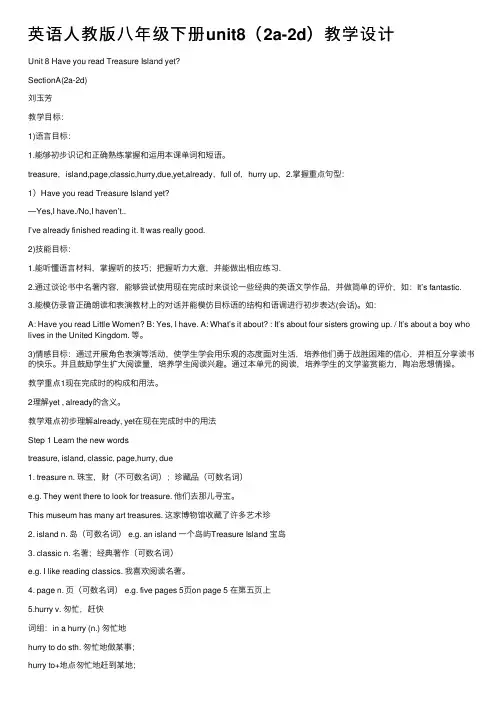
英语⼈教版⼋年级下册unit8(2a-2d)教学设计Unit 8 Have you read Treasure Island yet?SectionA(2a-2d)刘⽟芳教学⽬标:1)语⾔⽬标:1.能够初步识记和正确熟练掌握和运⽤本课单词和短语。
treasure,island,page,classic,hurry,due,yet,already,full of,hurry up,2.掌握重点句型:1)Have you read Treasure Island yet?—Yes,I have./No,I haven’t..I’ve already finished reading it. It was really good.2)技能⽬标:1.能听懂语⾔材料,掌握听的技巧;把握听⼒⼤意,并能做出相应练习.2.通过谈论书中名著内容,能够尝试使⽤现在完成时来谈论⼀些经典的英语⽂学作品,并做简单的评价,如:It’s fantastic.3.能模仿录⾳正确朗读和表演教材上的对话并能模仿⽬标语的结构和语调进⾏初步表达(会话)。
如:A: Have you read Little Women? B: Yes, I have. A: What’s it about? : It’s about four sisters growing up. / It’s about a boy who lives in the United Kingdom. 等。
3)情感⽬标:通过开展⾓⾊表演等活动,使学⽣学会⽤乐观的态度⾯对⽣活,培养他们勇于战胜困难的信⼼,并相互分享读书的快乐。
并且⿎励学⽣扩⼤阅读量,培养学⽣阅读兴趣。
通过本单元的阅读,培养学⽣的⽂学鉴赏能⼒,陶冶思想情操。
教学重点1现在完成时的构成和⽤法。
2理解yet , already的含义。
教学难点初步理解already, yet在现在完成时中的⽤法Step 1 Learn the new wordstreasure, island, classic, page,hurry, due1. treasure n. 珠宝,财(不可数名词);珍藏品(可数名词)e.g. They went there to look for treasure. 他们去那⼉寻宝。
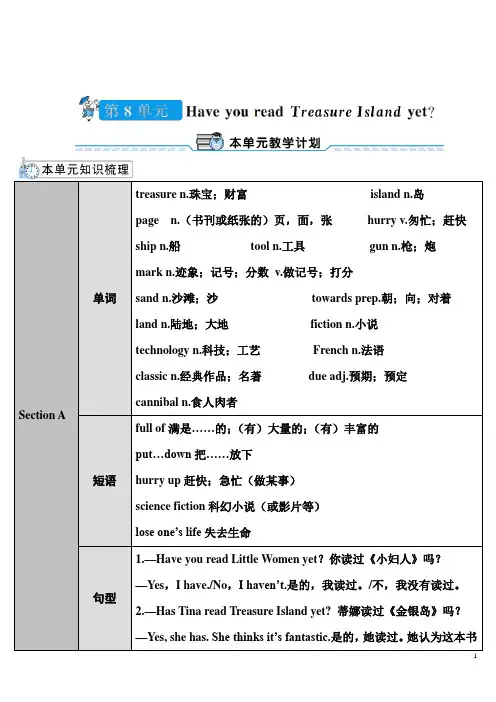
Section A 单词treasure n.珠宝;财富island n.岛page n.(书刊或纸张的)页,面,张hurry v.匆忙;赶快ship n.船tool n.工具gun n.枪;炮mark n.迹象;记号;分数v.做记号;打分sand n.沙滩;沙towards prep.朝;向;对着land n.陆地;大地fiction n.小说technology n.科技;工艺French n.法语classic n.经典作品;名著due adj.预期;预定cannibal n.食人肉者短语full of满是……的;(有)大量的;(有)丰富的put…down把……放下hurry up赶快;急忙(做某事)science fiction科幻小说(或影片等)lose one’s life失去生命句型1.—Have you read Little Women yet?你读过《小妇人》吗?—Yes,I have./No,I haven’t.是的,我读过。
/不,我没有读过。
2.—Has Tina read Treasure Island yet? 蒂娜读过《金银岛》吗?—Yes, she has. She thinks it’s fantastic.是的,她读过。
她认为这本书句型1.Listening to The Toms is a good way to wake up.听汤姆乐队的音乐是让人清醒的一种好方法。
2.When Sarah was a teenager,she used to fight over almost everything with her family.当萨拉还是一个青少年时,她以前几乎每件事都要和家人争吵。
3.Many songs these days are just about modern life in the US,such as the importance of money and success,but not about belonging to a group.如今的许多歌曲仅仅涉及美国的现代生活,例如金钱和成功的重要性,而与群体归属感无关。
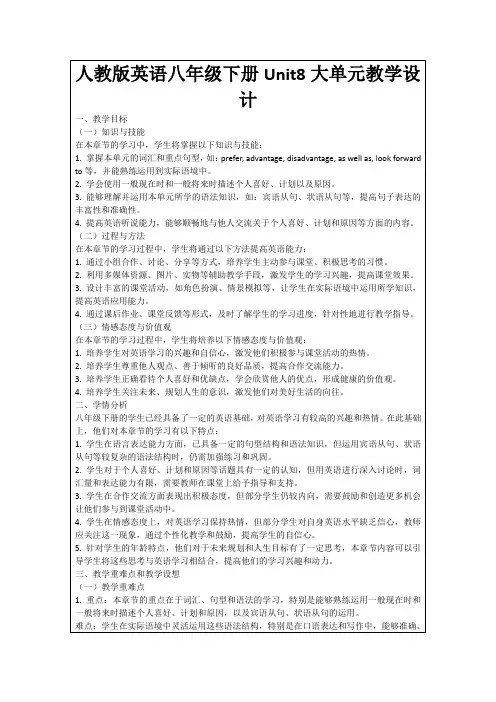
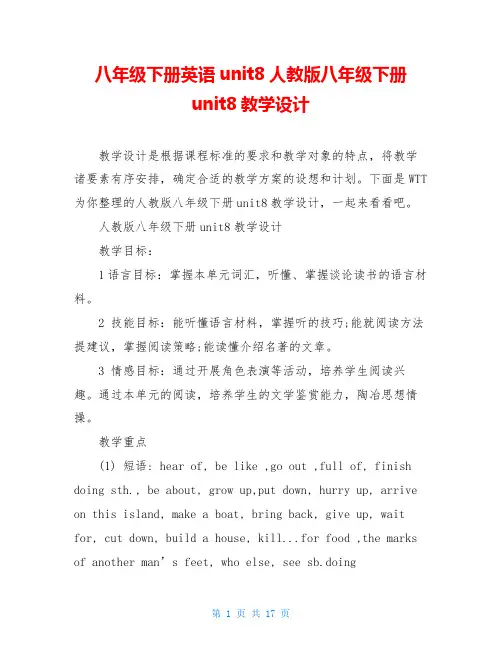
八年级下册英语unit8人教版八年级下册unit8教学设计教学设计是根据课程标准的要求和教学对象的特点,将教学诸要素有序安排,确定合适的教学方案的设想和计划。
下面是WTT 为你整理的人教版八年级下册unit8教学设计,一起来看看吧。
人教版八年级下册unit8教学设计教学目标:1语言目标:掌握本单元词汇,听懂、掌握谈论读书的语言材料。
2 技能目标:能听懂语言材料,掌握听的技巧;能就阅读方法提建议,掌握阅读策略;能读懂介绍名著的文章。
3 情感目标:通过开展角色表演等活动,培养学生阅读兴趣。
通过本单元的阅读,培养学生的文学鉴赏能力,陶冶思想情操。
教学重点(1) 短语: hear of, be like ,go out ,full of, finish doing sth., be about, grow up,put down, hurry up, arrive on this island, make a boat, bring back, give up, wait for, cut down, build a house, kill...for food ,the marks of anoth er man’s feet, who else, see sb.doingsth., run towards, help sb.dosth., name sb....,teach sb.sth.,be interested in ,can’t wait to do sth., used to,fight over, return home ,on the radio, make sb.do sth., think about, e to realize ,ever since, the home of, such as, belong to, be kind to sb., trust one another, remind sb.that...,havebeen to, do research on ,hope to do sth.introduce...to(2) 句子:Have you ever read Little Women yet?What’s it like?Oliver Twist is about a boy who goes out to sea and finds an island full oftreasures.Steve, have you decided yet which book to write about for English class?Although I have lost everything, I have not lost my life.How long have they been here?So I will not give up and I will wait for another ship.Not long after that, I saw some cannibals trying tokill two men from a broken ship.One of them died, but the other ran towards my house.I named him Friday because that was the day I met him.Every time she is in the library, Sally looks at the many books she hasn’t read yet and can’t wait to read them.When Sarah was a teenager, she fought over almost everything with her family.Ever since then, she has been a fan of Americancountry music.It reminds us that the best thing in life is free....Sarah hasn’t been to Nashville yet, but it is her dream to go there one day.He’s sold more than120 million records.Have you introduced the singer to others?(3)语法:现在完成时教学难点:现在完成时与一般过去时的区别.课时划分Section A11a –2dSection A2 3a-3cSection A 3 Grammar Focus 4a-4cSection B11a-2eSection B2 3a-3b Self check SummarySection A1 (1a –2d)Step1 Presentation1a Look at the picture.Haveyou read these books? Check (√) the ones you know.___ Alice in Wonderland ___ Little Woman___ Treasure Island ___ Olive Twist___ Robinson Crusoe ___ Tom SawyerStep2 Learn the new wordstreasure, island, classic, page, hurry, dueStep 3 Listening1.1bListen and plete the chart.BookTitle Name Have theyread it? What do they think of it? Treasure Island Nick -Judy √ excitingRobinson Crusoe Sandy -Alan √ wonderfulLittle women Kate √ fantastic Harry -Step 4 Speaking1c Practice the conversation.Thentalk about the other books in1a.ExlesA: Have you read Little Women yet?B: No, I haven’t.Haveyou?A: Yes, I have already read it.B: What’s it like?A: It’s fantastic.Step 5 Listening2a Listen.Whohas read these books? Circle the names.1.TreasureIsland Mark / Tina2.OliveTwist Mark / Tina3.RobinsonCrusoe Mark / Tina4.TomSawyer Mark / TinaKeys:1.Tina2.MarkTina 3.MarkTina 4.Tina2bListen again.WriteT for true and F for false.1.OliverTwist is about a boy who goes out to sea and finds an island full of treasures.()2.RobinsonCrusoe is a classic.()3.Tinathinks that Treasure Island is a fantastic book.( )4.TomSawyer is about a boy who lives in the United Kingdom.()Keys: FTTFStep 6 Speaking2c Use the information in2a and2b to talk about the books.A: Has Tina read Treasure Island?B: Yes, she has.Shethinks it’s fantastic.A: What’s it a bout?B: It’s about....2d Role –play the conversationStep 7 Language points and summary1.OliverTwist is about a boy who goes out to sea and finds an island full of treasures.《雾都孤儿》是一个男孩去海边发现一个充满珍宝的岛的故事。
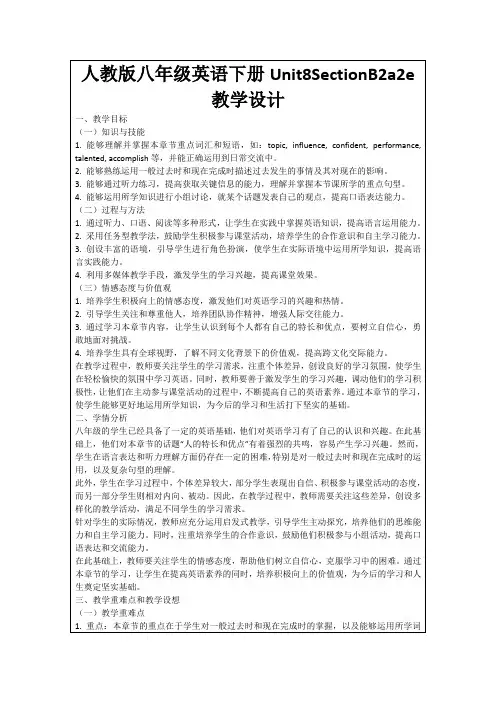
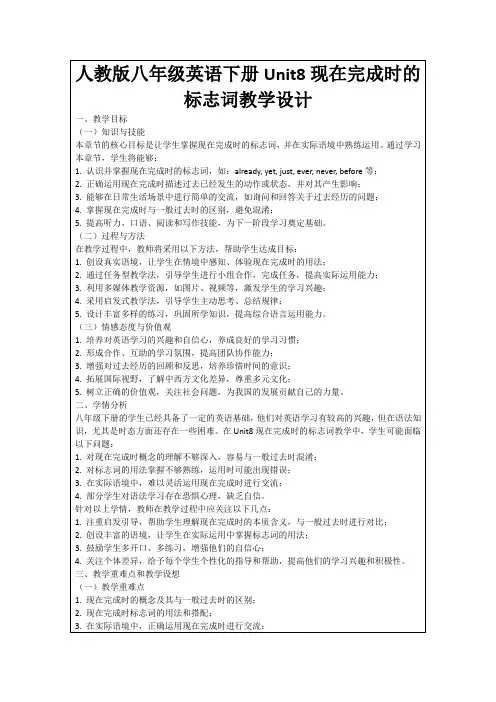
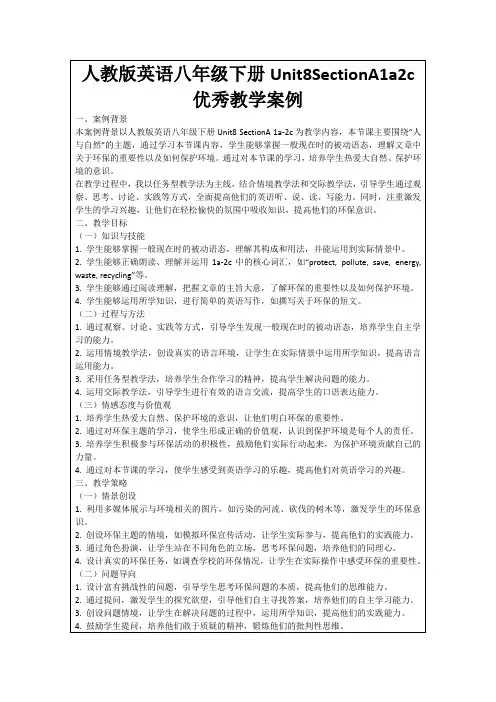
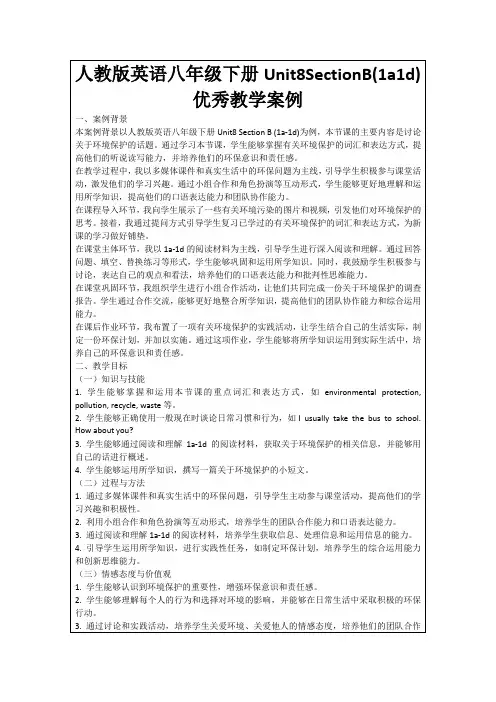
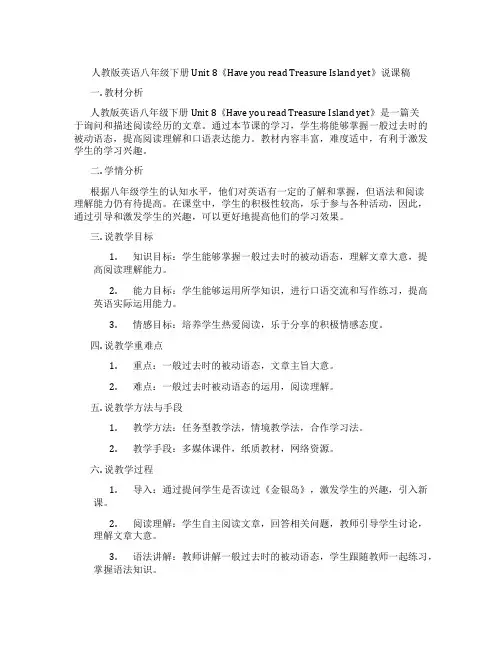
人教版英语八年级下册Unit 8《Have you read Treasure Island yet》说课稿一. 教材分析人教版英语八年级下册Unit 8《Have you read Treasure Island yet》是一篇关于询问和描述阅读经历的文章。
通过本节课的学习,学生将能够掌握一般过去时的被动语态,提高阅读理解和口语表达能力。
教材内容丰富,难度适中,有利于激发学生的学习兴趣。
二. 学情分析根据八年级学生的认知水平,他们对英语有一定的了解和掌握,但语法和阅读理解能力仍有待提高。
在课堂中,学生的积极性较高,乐于参与各种活动,因此,通过引导和激发学生的兴趣,可以更好地提高他们的学习效果。
三. 说教学目标1.知识目标:学生能够掌握一般过去时的被动语态,理解文章大意,提高阅读理解能力。
2.能力目标:学生能够运用所学知识,进行口语交流和写作练习,提高英语实际运用能力。
3.情感目标:培养学生热爱阅读,乐于分享的积极情感态度。
四. 说教学重难点1.重点:一般过去时的被动语态,文章主旨大意。
2.难点:一般过去时被动语态的运用,阅读理解。
五. 说教学方法与手段1.教学方法:任务型教学法,情境教学法,合作学习法。
2.教学手段:多媒体课件,纸质教材,网络资源。
六. 说教学过程1.导入:通过提问学生是否读过《金银岛》,激发学生的兴趣,引入新课。
2.阅读理解:学生自主阅读文章,回答相关问题,教师引导学生讨论,理解文章大意。
3.语法讲解:教师讲解一般过去时的被动语态,学生跟随教师一起练习,掌握语法知识。
4.口语练习:学生分组进行角色扮演,运用一般过去时的被动语态进行对话。
5.写作练习:学生根据课堂所学,撰写一篇关于阅读经历的短文。
6.课堂总结:教师引导学生回顾本节课所学,巩固知识。
七. 说板书设计板书设计如下:1.课题:《Have you read Treasure Island yet》2.教学内容:–阅读理解:文章主旨大意–语法知识:一般过去时的被动语态3.课堂活动:八. 说教学评价1.课堂参与度:观察学生在课堂活动中的参与情况,评价学生的积极性。
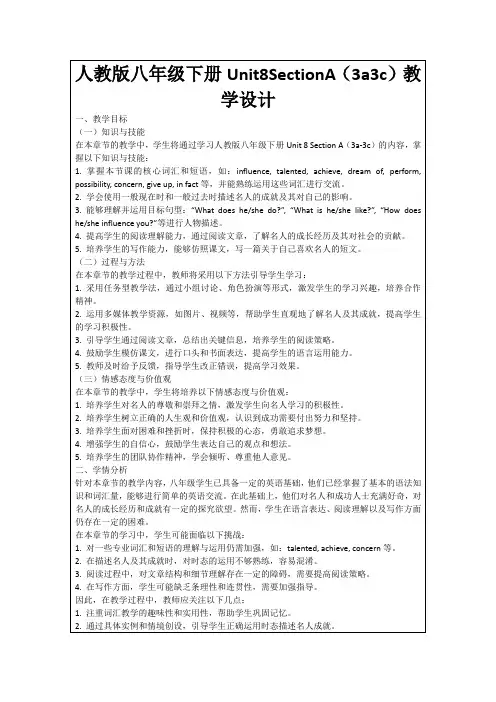
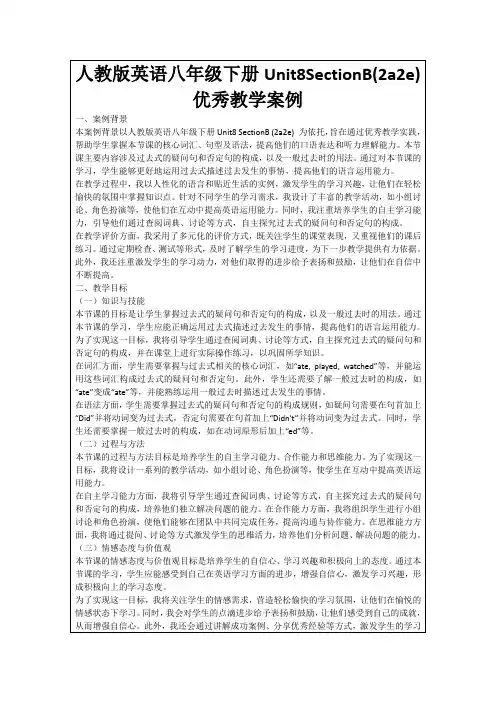
Unit 8 Have you read Treasure Island yet ?Section A 1a-2dTeaching Aims :1.Knowledge Aims:The students can master the following words and language chunks.(1)treasure island full of classic page hurry up due(2)Have you …yet ? Yes. I have already …/ No. I haven’t …yet.What do you think of it ? It’s…2.Ability Aims:Students can talk about recent events and experience.s by using “yet, already.”3.Moral Aims:Encourage the students to read more books .Teaching Key Points:1.learn and master the names of some books.2. learn to talk about the things they have done by using “yet, already.”Teaching Difficult Points:1.learn to use “have +动词过去分词”to talk about recent events and experiences.2.To understand the differences of “yet” and “already”Teaching Methods:Task-based language teaching method, the cooperative learning method and multimedia-assisted teaching learning method.Teaching Procedures:Step 1:Warming- up.Enjoy the English song: Way back into liveStep 2:Presentation and practice1.Watch the short videos of “Alice In Wonderland”, “Little Women”, “Treasure Island”, “Oliver Twist”, “Robinson Crusoe”, “Tom Sawyer”. and talk about the feelings.2.Sum up the Ajective words in the box and ask the students to talk about : What do you think of them?3.Look at the pictures of these books in 1a and practice the conversation:A: Have you read...yet ?B:Yes, I have already read it./ No, I haven’t read it yet.A:What do you think of it ?B:It’s...Step 3:Listening1.Show a chart to students.Book title name Have they read it ? What do they think of it ?(1)Alice in Island Nick Yes boring(2)Robbinson Crusoe Judy wonderful(3)Little Women Sandy interesting(4)Treasure Island Alan No fantasticKate exctingHarry2.Listen to the tape and match the answers.3.Have the students look at the chart and talk about them like this:A:Has Nick /....read...yet?B:No .He hasn’t..yet./ Yes. ....A:What does he think of it?B:He thinks it’s...4.look the pictures of books and talk about them again according to the questions.(1)What can you see from Tom Sawyer?(2)Is Robinson Crusoe a classic?(3)Does Tom Sawyer live in the United Kingdom or United States?5.listen to the tape and circle the names.6.Listen again and write T for ture and F for false.Step 4.2d1.look at some pictures and learn some phrases:on page 25 the back of the book book report2.Ask the students to predict :Has Steve finished reading?A: Yes .he does / No. he hasn’t.3.Read the conversation and answer the following questions.:(1).What does Steve think of Little Women?(2)Has Amy read the back of Treasure Island to see what’s about ?4.Play the tape for students to listen and imitate.Step 5.Homework.1.Make a survey: What books have the classmates read?2.Write a book report like this:I like reading books. I have already read...I think it’s ...and it tells about...Unit 8 Have you read Treasure Island yet?Section A 3a-3cTeaching Aims:1.Knowledge Aims:The students can master the following words:guns, ship, island, knives, mark, found, brought ,lost, cut,been,taught.2.Ability Aims:The students can understand the story.3.Moral Aims:Educate the students to read more books and read great books.Teaching Key Points:1.Be able to understand the story.2.Learn to talk about something they have done.3.Learn to introduce the books they have read.Teaching Difficult Points:1.Learn to read and understand the stories in English.2.Learn to understand the stories they have done.Teaching Procedures:Step 1:Warming-up1.Watch the video of Robinson Crusoe (about 3a) to students.Step 2:Before-reading1.look at the picture of 3a and predict:(1)Who are they? (2)Which one is Friday?2.Read the words in the box above and finish 3b.Step 3:While- reading1.Fast-reading:Skim the passage and answer the following questions:(1)What does Robinson Crusoe wait for?(2)Why does Robinson Crusoe call the man Friday?2.Careful-readingRead Para 1 and answer:(1)What has Robinson Crusoe done?(2)What will he do?Read Para 2 and answer:(1)What did he do a few weeks ago?(2)What did he see not long after that?Read the whole story and correct the sentences in 3C:Share the whole story according to the mind-map:helped...named...have taught...Step 4: After-readingHave the students talk about according to the questions:(1).What do you think of Robinson Crusoe?(2)What will you do if you are Robinson Crusoe?Step 5:Homework1.Search more story about some books.2.Try to write a book report about Robinson Crusoe?Unit 8 Have you read Treasure Island yet?Section A Grammar Focus --4CTeaching Aims:1.Knowledge aims:Students can use the key structures:(1)Have you...yet? Yes, I have. already../ No, I haven’t ...yet.(2)Has she/ he...2.Ability Aims:Learn and master how to talk about the things they have done.3.Moral Aims:Educate the students to read more books.Teaching Key Points:Master the Present perfect Tense with already and yet.Teaching Difficult Points:Learn to talk about the things they have done and master Present Perfect Tense. Teaching Methods:The activity teaching method, the cooperative learning method and the task-based language teaching method.Teaching Procedures:Step1:Warming-upLearn to sing the song : Way back into love.Step 2:Grammar Focus1.Show students some pictures to talk about the things they have done.T:Have you finished your homework yet?Ss:Yes, I have already finished it. / No. I haven’t finished it yet.T:Has Tina read Treasure Island yet?Ss:Yes, She has already read it.T:Has he cut down the trees yet?Ss:No,he hasn’t....yet.T:Have your parents had dinner yet?Ss:Yes, they have already had it .2.Have students read these sentences and sum up the Present Perfect Tense. Present Perfect Tense:构成:have /has +pp现在完成时可以和already(用于肯定句),yet(用于否定和疑问句)这些状语连用.3.Have students read and remember the sentences of Grammar Focus by themselves. Step 3.Practice(4a)1.Ask students read the words first and discuss in groups.2.Check the answersStep 4.Story Time (4b)1.Have students read Sally’s story and try to fill in the blanks with the correct forms .2.Discuss the answers in groups3.Show the questions to students to talk about Sally’s reading story.(1)Does Sally love reading?(2)What does she do in the morning or in the evening?(3)How many books has she read yet?(4)What’s her favorite kind of books?4.Have students talk about their reading stories.Step 5.Group work(4c)1.Have students read the conversation in 4c.2.Have students a survey in group according to the chart in 4c.3.Ask and answer in pairs.Step 6:Homework1.Share their reading stories in group.2.Write a coversation about music.Unit 8 Have you read Treasure Island yet?Section B 1a-1dTeaching Aims:1.Knowledge Aims:(1)The words: pop, rock,band, countryside(2)The structure: have+pp2.Ability Aims:Enable students to talk about their favorite singers and musicians by using Present Perfect Tense.3.Moral Aims:Learn to enjoy music and our lives.Teaching Key Points:Learn to talk about singers and musicians by using Present Perfect Tense. Teaching Difficult Points:Learn to introduce their favorite singers and musicians..Teaching Methods:The activity teaching method, the cooperative learning method, and the situational teaching method.Teaching ProceduresStep 1 Warming-up1.Enjoy some songs by “TF Boys, S.H.E, Super Junior, E.X.O”Students listen carefully and guess who are they?2.Watch videos about some bands and talk about feelings.Sum up and learn some phrases in the box.Step 2 Presentation and Practice(1d)1.Show some pictures of singers and musicians to students.2.Ask students to talk about them according to the following questions:(1)Have you heared him/ her?(2)What kind of music does she /he play?(3)How many CDs has she/he made?(4)Why do you like them? What do you think of them?Step 3 Listening1.Show the picture in 1b to students and talk about the band according to the questions.(1)How many teenage boys can you see?(2)What kind of music do you think can they play?2.Listen to the tape carefully and match the names and opinions.Alex The Toms must be popularThe Toms play pop music.The Toms’ music sounds more like rock.Dave Listening to The Toms is a good way to wake up.3.Listen to the tape again and fill in the chart.4.Read the chart and introduce “ The Toms”.Step 4 Wrting1.Students talk about their favorite singers or musicians according to the questions.(1)What’ your favorite singer?(2)What kind of music does he/ she play?(3)How many CDs has he/ she made?(4)Why do you like he/she?2.Write a short passage to intruduce :My favorite singer is______________________________________________________________________________________________________________________________________________________ _______________________________________________________________________________ __________________________Step 5 HomeworkExchange the passages in pairs and talk about the feelings.Unit 8 Have you read Treasure Island yet?Section B2a-2eTeaching Aims1.Knowledge Aims(1)Students can understand the following vocabulary words: country music ,forever,abroad,ever since,southern,modern,success,belong,one another,laughter,beauty,million,record,introduce.(2)Students can understand the article and know about the country music.2.Ability Aims(1)Students can make notes or underline the main ideas in the text while reading.(2)Students can write a short summary in their own words after reading.3.Moral AimsEncourge students to know about more American culture.Teaching Key Points1.The knowledge of Amercian country music.2.fight over, full of, ever since, belong to, one another,free-laughter, have been to, do research, one of... Sing live.Teaching Difficult PointsStudents can comb the stucture of the article according to the main ideas, to improve their ability to retell the article.Teaching MethodsThe activity teaching method, the cooperative learning method,and the institutional teaching method.Teaching ProceduresStep 1 Warming-upEnjoy an American country music.Step 2 Before-reading1.Look at the picture in 2b carefully and answer the questions to learn”country music”.(1)Where is she? (2) What is she doing?Step 3.While reading1.Fast-reading(1).Read quickly and and answer: Who and What does this article talk about?(2)Scan the passage and match the main ideas with the Para.Para 1 What kind of country music it isPara2 A famous country music placePara 3 Sarah has been a fan of American country music.(3).Read the passage and finish “Country Music Fact Sheet”.2.Careful-reading(1)Read Para 1and answer:Who is Sarah? Where is she from? What does she like?usedSheshe hasbeen____________________(2)Read Para 2 and answer:What is country music? What is country music about?(3)Read Para 3 and answer:What is Sarah’ dream? Who is Garth Brooks?Read Para 3 and finish mind-mapit.Step4. After-reading1. Watch a video to know about American country music.2.Have students to talk about American country music they know freely.Step5.HomeworkSearch more country music to enjoy and share with your classmates.Unit 8 Have you read Treasure Island yet?Section B 3a-self checkTeaching Aims1.Knowledge Aims Words and expressions in Unit 82.Ability Objects(1)Enable students to describe the things they have done.(2)Enable students to master the Present perfect tense.3.Moral ObjectsEncourage students to read more books and listen more music to enjoy our lives. Teaching Key PointsLearn to talk about the things they have doneTeaching Difficult PointsMaster the Present perfect tense.Teaching MethodsThe activity teaching method ,the cooperative learning method,and the situational teaching method.Teaching ProceduresStep 1 Warming-upEnjoy the country musicStep 2 Revision1.Have a dictation2.Ask the students to sum up the words and useful expressions according to the mind-map.Words: Nouns:_____________________________________________Verbs:_____________________________________________Adjectives:__________________________________________Adverbs:___________________________________________Sentence Structures: 1.--Have you read Little Womem______?--Yes ,I _______/No, I______________.2.--________Tina read Treasure Island yet?--Yes, she_________.3.-______you decided which book to write about yet?--Yes, I have. I have________finished reading it.plete Self check 2Step 3.Practice1.Make some sentences and conversations.plete Self-check 1.Step 4 Writing(3a and 3b)1.Read the questions in 3a and understand them.2.Ask and answer in pairs.3.Write a short passage to introduce their favorite writers/ singers..Step 5 Having a testStep 6 HomeworkPreview the words in Unit 9.。
八年级下册英语unit8人教版八年级下册unit8教学设计教学设计是根据课程标准的要求和教学对象的特点,将教学诸要素有序安排,确定合适的教学方案的设想和计划。
下面是WTT 为你整理的人教版八年级下册unit8教学设计,一起来看看吧。
人教版八年级下册unit8教学设计教学目标:1语言目标:掌握本单元词汇,听懂、掌握谈论读书的语言材料。
2 技能目标:能听懂语言材料,掌握听的技巧;能就阅读方法提建议,掌握阅读策略;能读懂介绍名著的文章。
3 情感目标:通过开展角色表演等活动,培养学生阅读兴趣。
通过本单元的阅读,培养学生的文学鉴赏能力,陶冶思想情操。
教学重点(1) 短语: hear of, be like ,go out ,full of, finish doing sth., be about, grow up,put down, hurry up, arrive on this island, make a boat, bring back, give up, wait for, cut down, build a house, kill...for food ,the marks of anoth er man’s feet, who else, see sb.doingsth., run towards, help sb.dosth., name sb....,teach sb.sth.,be interested in ,can’t wait to do sth., used to,fight over, return home ,on the radio, make sb.do sth., think about, e to realize ,ever since, the home of, such as, belong to, be kind to sb., trust one another, remind sb.that...,havebeen to, do research on ,hope to do sth.introduce...to(2) 句子:Have you ever read Little Women yet?What’s it like?Oliver Twist is about a boy who goes out to sea and finds an island full oftreasures.Steve, have you decided yet which book to write about for English class?Although I have lost everything, I have not lost my life.How long have they been here?So I will not give up and I will wait for another ship.Not long after that, I saw some cannibals trying tokill two men from a broken ship.One of them died, but the other ran towards my house.I named him Friday because that was the day I met him.Every time she is in the library, Sally looks at the many books she hasn’t read yet and can’t wait to read them.When Sarah was a teenager, she fought over almost everything with her family.Ever since then, she has been a fan of Americancountry music.It reminds us that the best thing in life is free....Sarah hasn’t been to Nashville yet, but it is her dream to go there one day.He’s sold more than120 million records.Have you introduced the singer to others?(3)语法:现在完成时教学难点:现在完成时与一般过去时的区别.课时划分Section A11a –2dSection A2 3a-3cSection A 3 Grammar Focus 4a-4cSection B11a-2eSection B2 3a-3b Self check SummarySection A1 (1a –2d)Step1 Presentation1a Look at the picture.Haveyou read these books? Check (√) the ones you know.___ Alice in Wonderland ___ Little Woman___ Treasure Island ___ Olive Twist___ Robinson Crusoe ___ Tom SawyerStep2 Learn the new wordstreasure, island, classic, page, hurry, dueStep 3 Listening1.1bListen and plete the chart.BookTitle Name Have theyread it? What do they think of it? Treasure Island Nick -Judy √ excitingRobinson Crusoe Sandy -Alan √ wonderfulLittle women Kate √ fantastic Harry -Step 4 Speaking1c Practice the conversation.Thentalk about the other books in1a.ExlesA: Have you read Little Women yet?B: No, I haven’t.Haveyou?A: Yes, I have already read it.B: What’s it like?A: It’s fantastic.Step 5 Listening2a Listen.Whohas read these books? Circle the names.1.TreasureIsland Mark / Tina2.OliveTwist Mark / Tina3.RobinsonCrusoe Mark / Tina4.TomSawyer Mark / TinaKeys:1.Tina2.MarkTina 3.MarkTina 4.Tina2bListen again.WriteT for true and F for false.1.OliverTwist is about a boy who goes out to sea and finds an island full of treasures.()2.RobinsonCrusoe is a classic.()3.Tinathinks that Treasure Island is a fantastic book.( )4.TomSawyer is about a boy who lives in the United Kingdom.()Keys: FTTFStep 6 Speaking2c Use the information in2a and2b to talk about the books.A: Has Tina read Treasure Island?B: Yes, she has.Shethinks it’s fantastic.A: What’s it a bout?B: It’s about....2d Role –play the conversationStep 7 Language points and summary1.OliverTwist is about a boy who goes out to sea and finds an island full of treasures.《雾都孤儿》是一个男孩去海边发现一个充满珍宝的岛的故事。
full of 满是......的;(有)大量的e.g.Thearea is full of beautiful lakes and rivers.这个区域有大量美丽的湖泊和河流。
2.Haveyou at least read the back of the book to see what it’s about?至少你已经读过书的背面,了解了它的大致内容吧?此句中的动词see表示“(通过查看、打听等)弄清、了解;查看、发现(信息或事实)”。
作这种用法时,see常接how, what,when等引导的宾语从句。
e.g.Heagreed to go with me to see what was wrong.他同意跟我去了解一下毛病出在哪里。
First of all, we need to take some time to see how it works.首先,我们需要花些时间了解一下它是运作的。
3.Youshould hurry up.你需要加快速度。
hurry up 赶快;(急忙)做某事e.g.Hurryup, or we cannot get to the railway station on time.快些,否则我们不能按时赶到火车站了。
4.Steve:...The book report is due in two weeks.读书报告两周后必须交。
Amy: Yes, I know...是的,我知道...1)due adj.预定;预期;预计后边引出预期的时间、地点等,还常常构成短语bedue(to do something)或be due (for something)。